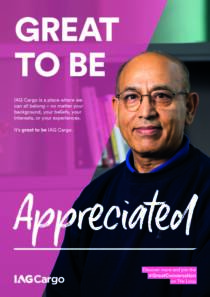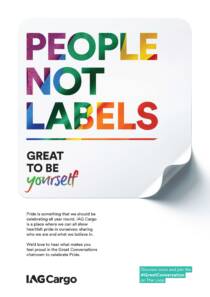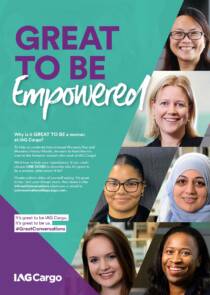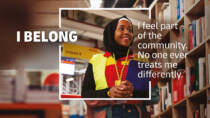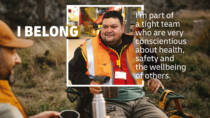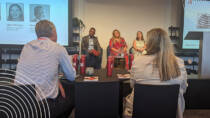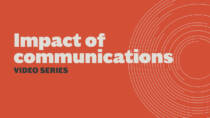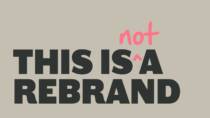Working with a B Corp creative agency: what to expect
By Sally Pritchett
CEO
As a B Corp creative agency, we're proud to contribute to a global movement that leverages business for positive change, making a meaningful difference to the world and those around us.
But what does that mean when you work with us?
Being a B Corp creative communications agency signifies our dedication to upholding the highest ethical standards throughout all aspects of our business. We try to do the right thing by not only our team, but our customers, their customers, our community, society, and the planet, all whilst balancing the need for profit in order to maintain a well-invested and thriving business.
In this article, we explore how being a B Corp creative agency benefits our customers, and what you can expect when working with a B Corp business.
Here are just some of the things you might notice.
Better service
As well as being a B Corp, we’re also an employee-owned business, which means everyone in our team is genuinely invested in creating great outcomes for our customers. Our staff retention is better than the average business which means our knowledge of your business grows as we maintain longer and more trusted relationships internally and externally.
Honest communication
Whether we’re delivering good news or not so good, you can expect transparency. We work in genuine partnership with our clients and external partners, built on honesty and trust. B Corp businesses are in trusted partnerships with society, the planet, and everyone they do business with, we’re seeking win:win opportunities.
End-to-end fairness with B Corp creative agency
From the way we work with our supply chains to the pricing we agree with our customers, we seek fairness. We’re not in a race to the bottom because we know that somewhere along the line either the planet, our team or our suppliers pay the price.
Always striving to de-carbonise
We consider the planet in every decision we make, we’re committed to de-carbonising and we will work closely with you to support you to make the most sustainable choices.
For example, all the paper we use for your production needs is FSC Certified and carbon-balanced (and chlorine and acid-free). We also use vegan inks where possible. We use efficient printing methods that optimise water and energy usage, and we recycle as much as we can. Our print suppliers, like us, hold Planet Mark certification, signifying our joint commitment to measuring and reducing our environmental footprints.
We’re inclusive
A big part of fairness is making sure everyone is included, represented authentically, and has a voice. We work hard and have stringent processes in place to make sure our work is diverse and represents everyone in a way that resonates with them. We set high standards of education and awareness on diversity, equity, inclusion and belonging internally and will guide you where it’s appropriate.
We believe in progress, not perfection
We know that moving forward isn’t always linear. We’re curious and always learning about new ways to improve, what’s right today may be different in the future so you can expect us to constantly change and evolve.
Everyday impact
We recognise that impact comes in all shapes and sizes. We value small impacts just as much as major ones, as they collectively contribute to positive change.
Recommendations and referrals
The B Corp movement is a global community of connected and like-minded organisations, so we’ll often recommend other B Corp agencies or businesses to our clients if we feel their services would be useful.
Does this sound like the kind of relationship you’d like to have with your agency partner?
If so, great news. As a certified B Corp creative agency we’d love to hear from you, or you can search for all the great B Corp businesses here.
How to build an inclusive workplace culture through authentic conversations
By Sally Pritchett
CEO
In this article, we explore how genuine and authentic conversations can help foster inclusive workplace cultures that unite global teams.
Inclusive workplace cultures are rapidly becoming a top priority for businesses dedicated to boosting creativity and innovation, increasing employee retention, and enhancing overall wellbeing.
A study by the Boston Consulting Group found that employees in workplaces with inclusive cultures were 81% happier in their jobs – three times more than those who didn’t feel included. However, the commitment to an inclusive workplace culture must be visible throughout the organisation, involving all employees from top to bottom.
So, how can you make an inclusive workplace culture visible and start authentic conversations around diversity, equity, and belonging? It can be a daunting task, especially when dealing with an international, disconnected and geographically diverse workforce.
Case study: Building an inclusive workplace culture with ‘Great to Be’
Following a drastic increase in the role of air cargo during and after the Covid-19 pandemic, IAG Cargo experienced extensive and rapid growth – a trend set to continue.
Despite investment in refreshing the IAG Cargo brand mission, vision, and values, employee engagement, pride, and loyalty remained low. The Organizational Health Index (OHI) results also highlighted a gap in reaching the frontline, raising concerns about the fragmented workforce lacking a cohesive sense of belonging and connection to the IAG Cargo brand.
As a naturally diverse business due to its international presence across over 80 countries, inclusivity wasn’t being felt across the global workforce. This was further exacerbated by some employees being directly contracted by the airlines, not the IAG Cargo business, presenting an additional barrier to belonging.
A critical need arose for a new approach to engagement, recognition, and retention. This was the start of ‘Great to be’.
Uniting a global workforce
How did we address this challenge and unite an international and fragmented workforce across 80 countries, creating a sense of belonging?
- Diversity and inclusion were integrated into everyday conversations to create an environment where everyone felt safe to contribute their knowledge and perspectives.
- We launched ‘Great to Be’, a long-term campaign that recognised key DEIB and wellbeing calendar events, demonstrating IAG Cargo’s longstanding commitment.
- The culture change originated from the top, with leadership sponsors championing events and speaking candidly about their own experiences.
- Managers were equipped to become more inclusive leaders, ensuring that everyone was seen, heard, and given the opportunity to succeed.
- Spaces for conversations were created, allowing for open, honest dialogues, and providing a safe place for employees to ask questions and share stories.
- ‘Great to Be’ is just the start of IAG Cargo’s journey towards creating a workforce where all employees could belong. The campaign not only served as a launchpad to unify its workforce but also encouraged continued conversations around crucial diversity and inclusion topics.
To find out how we can help you initiate authentic conversations DEIB with your employees as you look to foster an inclusive workplace culture, get in touch with us today.
Building a culture of belonging across diverse countries and cultures
By Sally Pritchett
CEO
Discover how we helped a global business to foster a culture of belonging.
Enhancing performance and cultivating loyalty, a culture of belonging encourages united dedication and purpose across a business. As Tony Bond, SVP, Chief Diversity & Innovation Officer at Great Place To Work explains: “Diversity is being invited to the party, inclusion is being asked to dance and belonging is dancing like nobody’s watching, because that’s how free you feel to be yourself.”
Why does belonging matter?
Belonging is not just a buzzword. According to Deloitte’s 2020 Global Human Capital Trends survey, 79% of organisations consider belonging important for their achievements. Research conducted by BetterUp revealed that when employees feel a sense of belonging, businesses experience large benefits, including improved job performance by 56%, a 50% lower risk of turnover, and a 75% decrease in employee sick days.
Creating a sense of belonging across countries and cultures is essential for global businesses looking to foster unity, collaboration, and innovation among diverse teams. But global campaigns can face unique challenges due to cultural differences, language barriers, and varying workplace practices. Tailoring your campaign to resonate with employees from different backgrounds while maintaining a consistent message of belonging requires careful planning, cross-cultural collaboration, and sensitivity to specific regional needs.
Case study: Making belonging part of the everyday conversation
Spanning 220 countries and territories, with a global workforce of around 600,000, DHL Group realised that they were not fully tapping into the potential of their diverse workforce. To celebrate the diversity of their employees and foster inclusivity they recognised the need to help all employees feel that they belong.
We distilled the concept of belonging into a simple and relatable campaign – and that was the start of ‘I Belong’.
Our creative strategy made the concept of belonging relatable and simple, for all. The results of the campaign were remarkable, seeing high engagement on both internal and external channels, which we put down to four key reasons.
- Real employees took centre stage, sharing their stories of how belonging extends from their personal lives into the workplace. Through blended images, the campaign showcased the authentic experiences of employees, fostering authenticity and unity.
- We leveraged the power of user-generated content by creating a versatile frame device. This device enabled employees to share their stories across internal and external channels, and was accessible across countries and cultures.
- To ensure global consistency, a comprehensive global toolkit was created, including campaign assets, videos, and a user-generated content toolkit for employees. This facilitated engagement across diverse regions and cultures within the organization.
- The campaign utilized the #iBelong hashtag and frame template, resonating with employees of different genders, ages, ethnicities, and cultures. By amplifying the campaign across internal and external channels, equal access was provided for all employees to participate and contribute their authentic stories.
Through employee engagement and participation, ‘I Belong’ encouraged individuals to share their authentic stories, creating a platform for open dialogue and connection. The global reach and impact extended the message of inclusivity beyond the organization, fostering connection among employees, reinforcing the importance of belonging and diversity in the workplace.
Colleagues all around the world have posted the template with their belonging stories. Our internal DEIB social wall is just flooded posts and people keep on posting. We can already say after a few days it is a very successful campaign engaging so many colleagues who are proud to work for DHL Group!
Head of Corporate Team in Digital & Internal Comms, DHL Group
Creating a culture of belonging across countries and cultures is an ongoing journey. Contact us today to chat about how we can support you in building a culture of belonging across countries and cultures.
Key insights on diversity, equity, inclusion, and belonging from the UK's Best Workplaces™
By Sally Pritchett
CEO
Want to create a more diverse, equitable, and inclusive workplace? In this blog we share insights from the UK's Best Workplaces™ on how to create a culture where everyone feels valued, respected, and heard.
Last week, we had the privilege of taking part in Great Place to Work‘s first ‘For All Community’ event. The inaugural event gathered the UK’s Best Workplaces for meaningful discussions on diversity, equity, inclusion, and belonging (DEIB).
We heard from DHL (the World’s Number 1 Best Workplace) and our CEO, for a panel discussion on DHL’s global group-wide approach to belonging. Speakers from Cisco (the UK’s current Number 1 Best Workplace), Vodafone and Version 1 discussed the balance of DEIB in today’s world, with a focus on the role of employee resource groups (ERGs). We then heard from The Prince’s Trust, as they shared how ‘listening into action’ can make an impact.
To help you to foster an inclusive and equitable workplace, we have compiled some key insights from the event:
Prioritise communications
Clear and effective communication emerged as a vital element of successful workplaces. An analysis of anonymous feedback from the UK’s Best Workplaces revealed that strong communication was a top reason employees choose to stay. To build trust and transparency, alignment and understanding, and empower the employee voice, businesses need to prioritise their communication practices.
Connect the dots
While the ultimate responsibility for DEIB may vary across organisations, it is crucial for the communications and HR teams to work together and support each other. By fostering a strong partnership, these teams can develop and put in place DEIB strategies that drive positive change.
Maximise the potential of surveys
The phrase ‘what gets measured gets done’ was regularly repeated. Several speakers emphasised the significance of measuring progress to ensure meaningful change. Employee surveys can help you to gather valuable insights and enable you to prioritise employee feedback. Focus on improving survey response rates to gain a deeper understanding of your organisation’s DEIB landscape.
Listen to employee feedback
Actively listen to employees. Provide them with feedback on the insights learned from surveys or other channels. Play back what you’ve heard, what you’re going to work on, how they can help change, the timescales for actions. If there is anything difficult to solve be clear on this and set expectations.
Support ERGs
Employee resource groups and networks play a pivotal role in creating inclusive environments. Organisations need to value the expertise that sits within their ERGs, celebrate them, and provide adequate support and resources. Empower your ERGs to have clear missions and amplify their voices within the organisation.
Encourage human leadership
Leadership plays a critical role in shaping the company culture. Encourage leaders to lead with compassion and vulnerability, fostering an environment where open conversations about DEIB can thrive. Equip them with the necessary tools and resources to navigate sensitive discussions effectively and drive meaningful change from the top.
Foster a psychologically safe culture
Creating a psychologically safe workplace is essential for promoting DEIB. Establish an environment where mistakes are seen as learning opportunities. Equip your teams with the tools so that they can address harmful behaviour through “calling in” rather than “calling out”. Foster open conversations, provide education and awareness programs, and create safe spaces for employees to learn and grow.
Treat people as individuals
Every employee brings their unique identity and experiences to the workplace. Even within a global business with tens or hundreds of thousands of employees, recognise and respect individuality, valuing the diverse perspectives and talents that each person contributes.
Within all the discussions and insights shared at the For All Community event, one key message resonated strongly: do what you can today to keep diversity, equity, and inclusion moving forward. Each day presents an opportunity to make a meaningful difference.
We’re here to help you with your DEIB efforts, supporting you with impactful and authentic communications that foster a genuine sense of belonging.
Diversity and Inclusion Calendar
By Sally Pritchett
CEO
We have created a comprehensive, downloadable, diversity and inclusion calendar for 2023 - so you never miss an important date.
Diversity and inclusion isn’t a short-term objective that you can tick off the list – it’s an ongoing commitment to ensuring that every individual in your workforce feels heard, respected and valued, and has an equitable opportunity to fulfil their potential.
This calendar has been designed to help you keep your diversity and inclusion employee engagement programmes on track. Our DEI calendar includes a wide range of cultural, racial, religious, age, gender, sexual orientation and disability awareness dates.
DOWNLOAD YOUR FREE COPY
Impact of Communications
Communication is a powerful tool.
When used effectively, it can help to build relationships, create understanding, and inspire action. In the workplace, effective communication can help to improve employee engagement, boost morale, and increase productivity. It can also help to attract and retain top talent, build a strong brand reputation, and achieve organisational goals.
In this video series we’re exploring the impact of communications, from how to effectively communicate purpose to creating inclusion and belonging in the workplace, from how to break down stigmas to supporting employees to find balance and wellbeing. At Something Big we’re passionate about creating change and making a meaningful difference and in this series we explore how communications can achieve long-lasting impact.
Communicating impact
Hannah Keartland collaborates with business leaders who are committed to making a significant positive impact on people and planet. In this video, Hannah and our CEO, Sally Pritchett, delve into how purpose-driven organisations can effectively communicate their social and environmental impact.
If you’re seeking to communicate your business’ purpose and impact in an effective and meaningful way, we’d love to hear from you. Get in touch
The art of delivering bad news
Receiving bad news can be challenging, particularly when the delivery is less than ideal. As humans, we can struggle to process difficult information, and it can be hard to know how to communicate effectively in such situations. In this video, Nicola Bush offers valuable insights on how to deliver bad news in a compassionate and effective manner.
Get in touch to see how we can help you to navigate difficult conversations with empathy and professionalism. Get in touch
Embracing neurodiversity
In this video, our CEO, Sally Pritchett, emphasises the need for businesses to become better allies to the neurodiverse community and to make accommodations and adjustments for everyone, regardless of diagnosis. She also discusses the importance of creating networks to support employees and celebrating the potential of the neurodiverse community.
Chat to us to find out how we can help you to create culture of trust and inclusivity. Get in touch
Supporting frontline workers
Many employers have risen to the challenge of hybrid working and demands for a better work/life balance, but it seems that the world has changed for everyone except those on the frontline. In the context of widespread industrial action in the UK, in the video, Strategy & Insight Director, Tor Radford, asks the question, how can the employee experience for frontline workers be improved? Tor discusses how better considered communications could help close the gap between operational and corporate staff.
If you are struggling to reach and engage your frontline employees, talk to us to see how we could help. Get in touch
Taking the taboo out of menopause
In this video, Account Director Emma Bond discusses women’s health, with a specific focus on breaking down the stigma surrounding menopause. Emma explores why businesses should create a supportive culture of psychological safety that enables women to thrive.
If you’re looking to tackle taboos, such as menopause, in your workplace, talk to us to see how we can help. Get in touch
The crossover of internal and external comms
Every piece of internal communication has the power to either strengthen or damage your brand. In this video Adam Longobardi discusses how the rise of social media and a competitive job market has led to the growing crossover between internal and external comms.
Talk to us about how you can increase the impact and creativity of your internal communications campaigns. Get in touch
Creating inclusion and belonging in the workplace
Recorded at our team meeting, in this video our CEO, Sally Pritchett, is joined by experts in diversity and inclusion, for an insightful discussion on how businesses can better create inclusion and belonging in the workplace.
If you’re looking for support in developing a diversity and inclusion strategy that fosters a sense of belonging for all employees, we’re here to help. Talk to us about how we can create a customised and creative communications program that aligns with your business values and goals. Get in touch
Life-saving communications in the workplace
Effective internal communications can have a profound impact on raising awareness of mental and physical health issues among employees, driving positive change, and sometimes even saving lives. In this video, Account Director, Katie Klingenfus, explores the role of internal communications and health awareness programs in improving the health and wellbeing of employees.
We have heaps of experience in creating employee engagement programmes that enact real change and help support employee health and wellbeing, talk to us to find out more. Get in touch
Achieving balance in the workplace
Women often experience numerous life stages throughout their careers, including potential pregnancy and returning to work after maternity leave, to perimenopause and menopause. In this video, Account Director, Emma Christie-Hall, highlights the cultural shift needed to enable employers to better support their employees in finding balance throughout their careers.
Cultivating psychologically safe workplaces requires strong communication and company culture, chat to us to see how we can support you. Get in touch
The secret to winning the talent war
In the never-ending battle for top talent, what will set your business apart from the rest? In this video, our Commercial Director, Felicity Allen, draws upon her extensive experience in recruitment and retention within a highly competitive job market, and highlights the crucial role of purpose and culture in attracting and retaining top talent.
If you’re fighting in the talent war, we have lots of experience with creative campaigns that cut through the noise. Get in touch
TURN
IT UP
We turn up to make sure the right messages are heard – loud and clear.

This is not a rebrand
By Sally Pritchett
CEO
At Something Big, we’ve been on a journey of meaningful change.
For nearly twenty-five years, we have always tried to do the right thing by our clients, our people and our world, and that passion is stronger than ever – but we also want to reach further.
In recent years we’ve been looking at every aspect of what it means to be a business in the modern world, taking time to listen, research and learn.
We’ve enthusiastically embraced the benefits of a more flexible workplace, focused on creating an atmosphere of belonging, and made all kinds of changes that will help us have a more positive impact upon the world.
Our goal has been, and remains to be, to help talented people do great work for clients who share our passion to make a meaningful difference to our society and our planet.
Our brand change has put making a ‘meaningful difference’ at the very heart of our business, exactly where it should be. We’re taking action to create a better future for all. We’re stepping up to the challenges our society and planet face, and we’re doing it in a way that’s accountable, robust, and permanent.
Did you know that we are part of the following initiatives?
B Corp
We are proudly B Corp Certified, and part of the global movement driving business to be a force for good. This means we strive to make a positive impact on society and our planet, and we are held accountable for our actions. Find out more.
Employee-owned
We’re an employee-owned business, which means we all work together for the success of the company and, when the company does well, we all benefit. Find out more.
Great Place to Work®
We’ve been independently recognised by Great Place to Work® as a Best UK Workplace™ for women and wellbeing, based on feedback from our employees. Find out more.
Planet Mark
As a Planet Mark-certified business, we’re looking to positively transform the planet by measuring and reducing our environmental impact. Find out more.
We’re determined to continue to make a positive impact to people and planet, and our updated brand now better reflects this.
For a personal story from our CEO, Sally Pritchett, check out her recent LinkedIn article here. Sally explains how she was inspired by Mary Portas when she said: ‘It’s time to grow the trees we won’t sit beneath’.
So, although we have a fresh new logo and our website may have had a makeover, this is not a rebrand. It’s our commitment to always creating a meaningful difference – for our clients and their employees, for our team, for society and for our planet.
7 March 2023
ESG communications: how to get your story started
By Sally Pritchett
CEO
In this blog we’ll help you get to grips with ESG communications and get you started on telling your ESG story.
As a communications professional is likely that you’re increasingly seeing and hearing the term ESG (Environmental, Social and Governance).
The world has changed, and internal and external stakeholders are increasingly holding businesses accountable for the impact they’re having on our planet and society. Across the globe, brands have been allocating more resources towards improving their ESG credentials, instigating a radical change in how brand value is viewed. For ambitious organisations, how they communicate their ESG activities should be sitting at the heart of their growth strategies.
The complexities of ESG communications
This topic is complex to navigate, so you’re not alone in feeling that way. The first thing we hear from the communicators we work with is that this topic can feel overwhelming, not only in its broad scope but also in finding the balance between speaking up on the actions being taken and being transparent, whilst also getting the right tone and avoid greenwashing.
For example, on the environmental side of things:
- The calculations and terminology around carbon emissions are highly complex
- The definitions around buzz words like ‘net zero’ and ‘carbon neutral’ are technical and often misunderstood
- The carbon cost of everything
- The finer details of what is the more sustainable choice is often complex, such as the balance between ‘paperless’ which sounds better but in practice requires a large amount of (often carbon-emitting) cloud storage
In social terms again there is also complexity, for example with law and social norms varying across the world. What feels like a complete injustice that needs to be solved in one part of the world, could actually be putting your employees at risk in another.
Getting started with ESG communications
The topic is complex topic, so it’s let’s get started with some simple advice.
Find the experts: Whether you’re writing for a large or small organisation, get as close as you can to the leadership team who will be at the heart of any goals and commitment to actions. It’s important you’re telling the right story. If you’re in a larger business, stick close to the experts you have, like your Sustainability Lead, People Director, Head of Corporate Affairs etc. These will be the people who can help you navigate the complexity.
Stay in your lane: Your organisation cannot solve climate change or societal inequality all by itself. For you to structure your story well, you’ll need to narrow down the specific areas your business is working on and the themes you’re focusing on. It’s a great idea to create some clear pillars of focus and then you can talk specifically on these areas. There are some great examples of organisations who have done this well, like fellow B Corp, Tony’s Chocolonely. They have committed to making chocolate 100% slave free. Their mission specifically focuses on human rights and social injustice, giving them a clear path to stick to.
Stick to the facts: Be clear around facts and use plain language. ESG is not the topic to add a marketing spin to. Your ESG communications need to be about clarity, reducing jargon where you can, and being as clear in what’s being said as possible. Avoid big sweeping, vague statements and stick to the clear issues identified and the actions you’re taking.
Be honest and transparent: The best ESG stories are the ones that are honest, frank and candid.
Structuring your ESG story
Once you’re ready to tell your ESG story, it’s important to consider structure. Every good story has a beginning, a middle and an end. If we look at ESG through this lens then your structure could be something like:
- The beginning – is where you are right now, the challenges your sector or industry is facing, and the problems your organisation is identifying.
- The middle – is about describing what you’re committing to doing about it, the actions you’re taking and the changes you’re making. This may be the pillars we mentioned earlier and will be generally positioning your organisation in terms of the journey you’re on.
- The end – is about the big goal. This is your ambition.
Some might say that the big goal should be the beginning of your ESG story, but we would encourage caution in that. It’s always good to start any mission with an end goal in mind, but leading an ESG story that way is how organisations have often fallen foul of mistrust. Communicating the big goal without the evidence of action to back it is a risky choice. Instead there’s an opportunity to build trust by talking about action first, and ambition last.
Corporate washing is a big problem, and consumers and employees are increasingly becoming skeptical of large brands making big ESG claims. If you’re nervous about how your ESG story will land, then try launching it in a safer space initially. Start with an internal launch, like with your leadership team, ERG groups, or other ESG champions in the business. These kinds of previews should uncover any questions or concerns that might come up later on, and will enable you to either prepare for them, or to add to your story.
Structuring your ESG story
Once you’re ready to tell your ESG story, it’s important to consider structure. Every good story has a beginning, a middle and an end. If we look at ESG through this lens then your structure could be something like:
- The beginning – is where you are right now, the challenges your sector or industry is facing, and the problems your organisation is identifying.
- The middle – is about describing what you’re committing to doing about it, the actions you’re taking and the changes you’re making. This may be the pillars we mentioned earlier and will be generally positioning your organisation in terms of the journey you’re on.
- The end – is about the big goal. This is your ambition.
Some might say that the big goal should be the beginning of your ESG story, but we would encourage caution in that. It’s always good to start any mission with an end goal in mind, but leading an ESG story that way is how organisations have often fallen foul of mistrust. Communicating the big goal without the evidence of action to back it is a risky choice. Instead there’s an opportunity to build trust by talking about action first, and ambition last.
Corporate washing is a big problem, and consumers and employees are increasingly becoming skeptical of large brands making big ESG claims. If you’re nervous about how your ESG story will land, then try launching it in a safer space initially. Start with an internal launch, like with your leadership team, ERG groups, or other ESG champions in the business. These kinds of previews should uncover any questions or concerns that might come up later on, and will enable you to either prepare for them, or to add to your story.
Get in touch with us if you’re looking for help with telling your ESG story.
What is ESG, and why does it matter?
By Sally Pritchett
CEO
It’s likely that you’re increasingly seeing and hearing the term ESG.
In this blog, we’ll discuss exactly what ESG is and why it matters to all businesses. ESG (Environmental, Social and Governance) is no longer a niche term with an investment focus, but instead is now a mainstream business interest.
What is ESG?
The world is changing. Brands are under increasing pressure to behave in an ethical and fair manner, and to project a public image of transparency and responsibility. Customers and employees are reserving their loyalty for businesses who share their values, and more people are holding brands accountable for the impact they’re having on our planet and society. There was a time when ESG strategies were a ‘nice to have’ but with growing stakeholder expectations, it’s become a necessity that you simply can’t ignore.
ESG refers to three non-financial performance indicators that measure the sustainability and ethical impact of a business – Environmental, Social and Governance.
In brief, ESG includes:
- Environmental – how the business minimises its impact on the environment
- Social – how the business impacts wider society and workplace culture
- Governance – how the processes of decision-making, reporting, and logistics are handled
The Environmental scope of ESG
What is included under the Environmental indicator will largely be down to your individual business and sector. Broadly, Environmental will cover your sustainability journey, from calculating carbon emissions and your action plan to reduce them, to your journey to net zero or carbon positive. Environmental is all about the impact your business is having on the planet, how you’re mitigating or offsetting any negative impact, and anything you’re doing to make a positive impact on our environment. In our business, our Environmental strategy includes (but is not limited to) our carbon reduction plans, our carbon offsetting strategy and our commitment to leading a climate positive workforce. For other businesses Environmental could also include strategies to reduce waste, or innovations around tapping into clean energy sources.
The Social scope of ESG
The Social element of ESG is wider, covering everything to do with society. It’s all about people, be that your own workforce, your customers, or the community around you. Social is all about the way your business interacts with people and encompass your strategies and actions to create a safe, fair and positive environment where everyone can thrive. In practice this might include safety and wellbeing plans, diversity and inclusion strategies, employee culture and organisational values, as well as how your workforce might be supporting your local community through volunteering. As an example, in our agency, the Social element of our ESG strategy includes DEIB, safety and wellbeing, CSR, volunteering and community, as well as our work around our employer brand, culture, values and our commitment to being a Great Place to Work®. For other businesses this might include improvements in working conditions or negotiations for fair pay throughout their supply chain.
The Governance scope of ESG
This is the part that ensures that these strategies and action plans to make the world a better place don’t just get lost during day to day business. Good Governance ensures that your strategies are baked into the way your business is getting done. Governance is often data driven and includes policies that protect your strategies, like a code of conduct or a robust reporting structure that keeps things in check. Or maybe you have individuals in the organisation who are responsible for ensuring compliance. Every business will do things differently, but this is the part of ESG that holds everything to account, provides transparency, and gives evidence that supports the story you go on to tell. In our agency, our approach to Governance includes our commitment to the B Corp framework. This includes our annual impact report, as well as a series of policies and codes of conduct we maintain to hold ourselves accountable to the highest of ethical standards. We also have external partnerships with organisations like Planet Mark, who calculate and validate our carbon emissions. For other businesses this might include work to reduce corruption and bribery, increasing Board level diversity, or improving executive remuneration transparency.
The breadth and depth of what each business is doing under each of these core headings might be different, dependent on the size of business, sector, impact they’re making on the planet, and the scale to which they interact with people. What is consistent regardless of the specifics of your business is that your stakeholders are increasingly expecting your business to look to protect the triple bottom line: people, planet and profit.
Why ESG is important
Preventing a climate crisis is everyone’s responsibility, as individuals, as consumers, we all must change our behaviour, but organisations yield a broader power in this. Businesses have the power to make significant changes to the products we buy, to the way waste is disposed of and to how materials can be recycled. It’s every businesses responsibility to reduce the negative impact they have, and to invest in innovating for a more sustainable and equitable future.
And no business operates without people. Even the most automated, AI driven tech brands are ultimately run by people, motivated, engaged, and united teams. People who understand and lean into the vision of the organisation. Focusing on creating cultural environments that are not just safe physically, but also psychologically, that are open and collaborative, fair and nurturing, is what attracts and retains the best talent and enables both the business and the people to thrive.
So, doing the right thing by both our people and our planet is fast becoming a licence to operate as a business, but does it also make good commercial sense?
The commercial case for ESG
The commercial case for investing in long term commitments to ESG is growing. What may have been seen as a noble investment for only the most ethical, purpose-led businesses, has now shifted towards indirect penalties for businesses who don’t invest. Those penalties come in the form of stifled growth due to less engagement from their customers.
You don’t have to look far (or Google for very long) to find the very real statistics that show how far today’s consumer will go to boycott a brand that isn’t seen to act in an ethical or sustainable way, and this is a global sentiment. Consumers are now choosing sustainable products over less sustainable alternatives, they are seeking to understand how businesses are run, they want to see that organisations are behaving fairly, and this is impacting their buying decisions. For ambitious organisations, how they communicate their ESG activities should be sitting at the heart of their growth strategies.
So, what does all this mean for communications professionals? To prove what really matters to your business, you’ll need a strong ESG communications strategy. Empty promises and surface-level activism won’t be enough. You need to live and breathe your principles to really make a difference, so it’s time to level up your messaging.
Reach out to us if you’re looking for support with telling your ESG story.
How to effectively embed ESG within your brand
By Sally Pritchett
CEO
How can you, and why should you, incorporate ESG into your brand?
Many people know how important it is for businesses to have a solid ESG strategy, but actually embedding it into your brand is another thing altogether.
Why is ESG important for your brand?
Let’s start by going back to the purpose of branding. How you position your brand is about establishing a space in your customers’ minds – ensuring they can perceive your brand in the way that you intended. But in a world where transparency, cultural changes and business are increasingly put under the microscope, branding has become more complex and needs to do more than ever before.
We all know that the world has been through huge change over the last two and a half years – the pandemic alone influenced a lot of transformations in the corporate landscape, as well as a cultural shift outside of it. People are now more aware than ever of social inequalities, the ongoing impact of climate change, and how businesses conduct themselves – and this has encouraged brands to consider not only what they offer to the market, but how they run their business and the impact this has on people and the planet.
So what does this mean?
It means that what your brand stands for must work in harmony with your ESG strategy and how you run your business. In simple terms, it’s about walking the walk as well as talking the talk, and the way to communicate this effectively is by creating tangible, measurable benchmarks and being open, honest and transparent.
How do you effectively embed ESG within your brand?
Once you have an ESG strategy and clearly defined framework, you can start to communicate your messaging and really embed it within your brand.
The first step is to start tailoring your messages to your different audiences (such as shareholders and consumers) and produce content that will really resonate with them. You’ll need to work out which platforms you’ll use for these communications. You might choose social media for your external comms, but do you have particular channels that resonate with your customers vs the wider consumer audience? And for your internal comms, are there different channels for employees vs senior stakeholders?
Regardless of audience, it’s important to break down your messages into simple language using clear, concise information, underpinned with transparency and measurable facts. This demonstrates that you really can walk the walk, and your audience will be able to understand better and take away what they need to know.
How regularly should you update your audience?
Regular updates – you can utilise your social channels to deliver stories regularly, helping to build your brand in relation to your ESG strategy. It might as simple as ‘x number of employees undertaken training’, ‘ we’re working with a new supplier who shares the same vision of x’, ‘we’ve developed new programmes for staff to support their wellbeing’, or ‘we’ve made some sustainable updates to the business infrastructure’. All these small but consistent messages should have measurables in place to help to build your brand reputation.
Occasional updates – to capture a broader picture of achievement and tell a deeper story, you might want to communicate larger updates every few months or so. Video and animation can be very powerful tools here, as well as infographics and live webinars, allowing you to provide detail around the changes you have implemented to reach your vision. This gives you space to share more information and encourage an open, transparent and authentic narrative. Remember, ESG is part of your brand, it’s being communicated as part of your brand, and its messaging is reflective of your brand and how you are positively contributing to the world.
Annual updates – you should publish an in-depth review of your ESG each year, capturing the highlights and challenges you’ve experienced, faced and overcome. Brand integrity comes hand-in-hand with transparency, so it’s important to document any losses or pitfalls as well as your achievements. It’s good to remember that your ESG strategy should be constantly evolving, and it’s very much ok to adapt and change your strategy to mirror the outside world.
However often you decide to update your audience, your ESG communications should be treated with the same amount of love, care and attention as any other campaign you produce. Because you aren’t just selling a product, you’re strengthening and building your tribe who want to support you to make a meaningful difference.
If you’re looking for support with how to embed ESG within your brand, get in touch to see how we can help.




